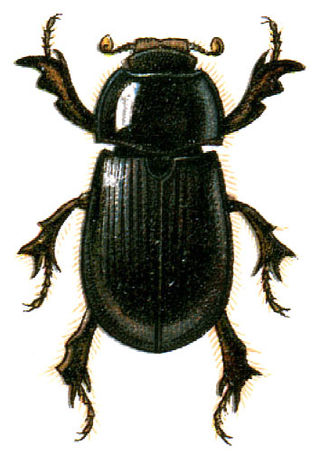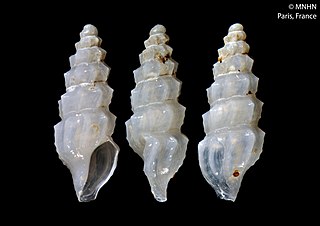
The black swan is a large waterbird, a species of swan which breeds mainly in the southeast and southwest regions of Australia. Within Australia, the black swan is nomadic, with erratic migration patterns dependent on climatic conditions. It is a large bird with black plumage and a red bill. It is a monogamous breeder, with both partners sharing incubation and cygnet-rearing duties.

Mambas are fast-moving, highly venomous snakes of the genus Dendroaspis in the family Elapidae. Four extant species are recognised currently; three of those four species are essentially arboreal and green in colour, whereas the black mamba, Dendroaspis polylepis, is largely terrestrial and generally brown or grey in colour. All are native to various regions in sub-Saharan Africa and all are feared throughout their ranges, especially the black mamba. In Africa there are many legends and stories about mambas.

Hybosoridae, sometimes known as the scavenger scarab beetles, is a family of scarabaeiform beetles. The 690 species in 97 genera occur widely in the tropics, but little is known of their biology.

Anthocoridae is a family of bugs, commonly called minute pirate bugs or flower bugs. Worldwide there are 500-600 species.
The wildlife of Alaska is both diverse and abundant. The Alaskan Peninsula provides an important habitat for fish, mammals, reptiles, and birds. At the top of the food chain are the bears. Alaska contains about 70% of the total North American brown bear population and the majority of the grizzly bears, as well as black bears and Kodiak bears. In winter, polar bears can be found in the Kuskokwim Delta, St. Matthew Island, and at the southernmost portion of St. Lawrence Island. Other major mammals include moose and caribou, bison, wolves and wolverines, foxes, otters and beavers. Fish species are extensive, including: salmon, graylings, char, rainbow and lake trout, northern pike, halibut, pollock, and burbot. The bird population consists of hundreds of species, including: bald eagles, owls, falcons, ravens, ducks, geese, swans, and the passerines. Sea lions, seals, sea otters, and migratory whales are often found close to shore and in offshore waters. The Alaskan waters are home to two species of turtles, the leatherback sea turtle and the green sea turtle. Alaska has two species of frogs, the Columbia spotted frog and wood frog, plus two introduced species, the Pacific tree frog and the red-legged frog. The only species of toad in Alaska is the western toad. There are over 3,000 recorded species of marine macroinvertebrates inhabiting the marine waters, the most common being the various species of shrimp, crab, lobster, and sponge.

An anchovy is a small, common forage fish of the family Engraulidae. Most species are found in marine waters, but several will enter brackish water, and some in South America are restricted to fresh water.

Syndromodes is a genus of moths in the family Geometridae.

Iwaoa is a genus of sea snails, marine gastropod mollusks in the family Horaiclavidae.
Chlanidota invenusta is a species of sea snail, a marine gastropod mollusk in the family Buccinidae, the true whelks.

Chlanidota is a genus of sea snails, marine gastropod mollusks in the family Buccinidae, the true whelks.

Agnorhiza invenusta is a species of flowering plant known by the common names Coville's mule's ears and rayless mule's ears. It is found only in California, where it grows in the Sierra Nevada foothills as in Fresno, Tulare, and Kern Counties.

Laphria is a genus described by Johann Wilhelm Meigen in 1803, belonging to the family Asilidae, subfamily Laphriinae. Members of this genus are known as bee-like robber flies. This genus has a Holarctic distribution, occurring in Europe, Asia, and North America. They prey on a variety of insects, including other robber flies, bees, wasps and beetles. Like other asilids, they use their proboscis to penetrate the body of their prey and inject enzymes which dissolve the tissues.

Charitometridae is a family of crinoids or feather stars in the phylum Echinodermata.
Ectemnia is a genus of 4 species of black flies. They are distributed in North America.
Dolecta invenusta is a moth in the family Cossidae. It is found in Brazil.

Agapetus is a genus of little black caddisflies of the family Glossosomatidae. There are at least 210 described species in Agapetus.

Neoligia invenusta is a species of cutworm or dart moth in the family Noctuidae. It is found in North America.

The fauna of Romania comprises all the animal species inhabiting the country of Romania and its coastal territory in the Black Sea.

Acanalonia invenusta is a species of planthopper in the family Acanaloniidae. It is found in New Mexico, Texas, and northern Mexico. It is quite visually similar to Acanalonia similis, though the two can be differentiated by A. invenusta having less prominent reticulation across its elytra. It measures 4.2 - 5.6 mm.

Acanalonia similis is a species of planthopper in the family Acanaloniidae. It is found in Texas, New Mexico, and Arizona. It is quite visually similar to Acanalonia invenusta, but though the two can be differentiated as A. similis has more prominent reticulation across its elytra than A. invenusta. A. similis measures 4.2 - 4.9 mm long.















